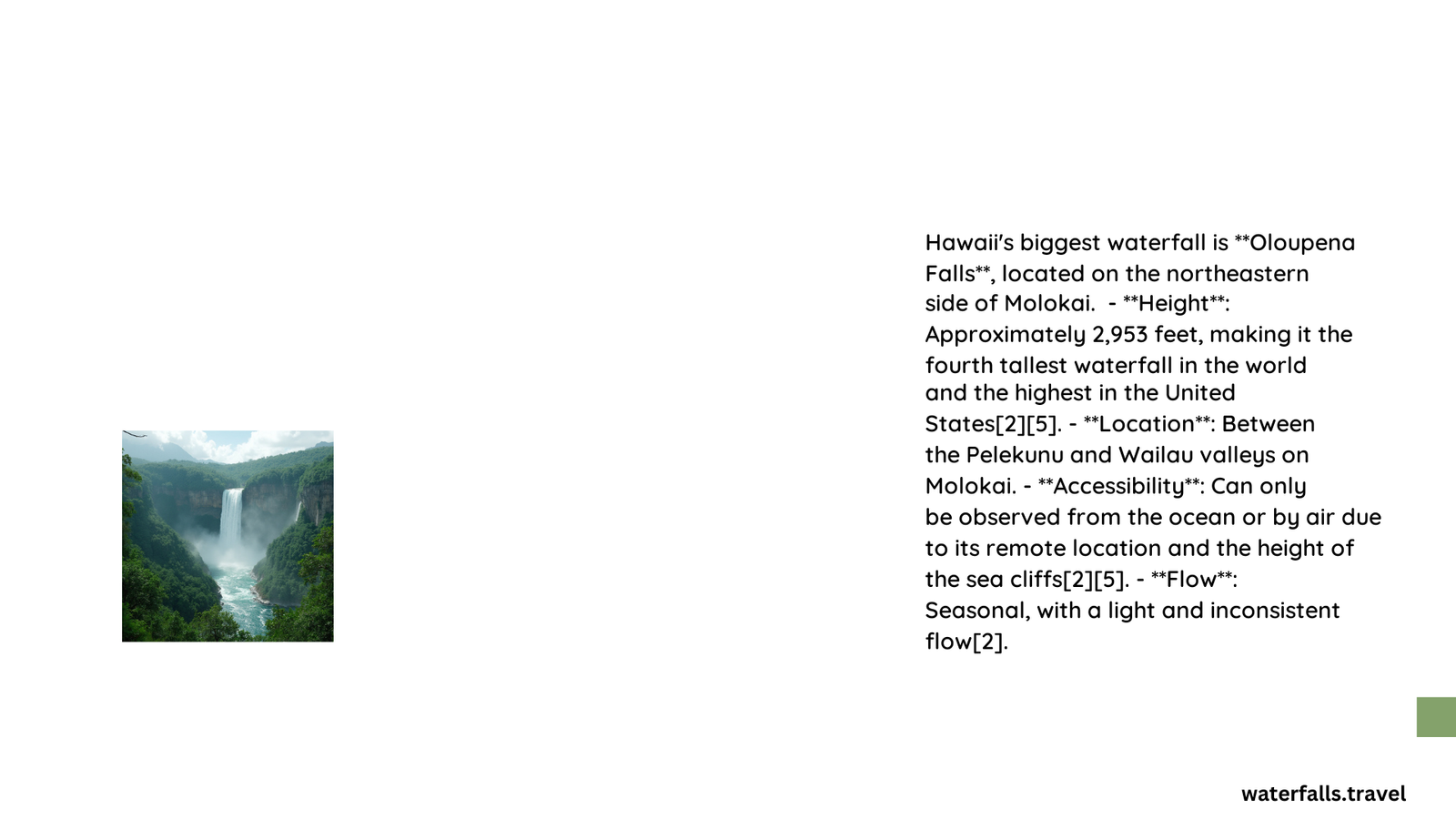Hi’ilawe Falls, located in the Waipio Valley on the Big Island of Hawaii, is the tallest waterfall in the state, standing at an impressive 1,450 feet. This majestic natural wonder is one of the most awe-inspiring sights in Hawaii, plunging dramatically from the lush cliffs of the valley. While its remote location and challenging access make it a less-visited attraction, Hi’ilawe Falls remains a crown jewel among Hawaii’s natural wonders, offering those who make the journey an unforgettable experience of raw, unspoiled beauty.
What Makes Hi’ilawe Falls Hawaii’s Biggest Waterfall?
Hi’ilawe Falls earns its title as Hawaii’s biggest waterfall due to its staggering height of 1,450 feet. This makes it not only the tallest waterfall in Hawaii but also one of the tallest in the United States. The falls cascade down in a single, uninterrupted drop, creating a spectacular sight that dominates the landscape of the Waipio Valley.
Key Features of Hi’ilawe Falls:
- Height: 1,450 feet
- Location: Waipio Valley, Big Island of Hawaii
- Type: Single drop waterfall
- Surrounding: Lush rainforest and steep cliffs
How Can Visitors Access Hi’ilawe Falls?

Accessing Hi’ilawe Falls is a challenging endeavor that requires careful planning and preparation. The remote location and rugged terrain make it one of the less accessible waterfalls in Hawaii.
Access Methods:
- Hiking: A strenuous hike through Waipio Valley
- Shuttle Services: Local shuttle services available for valley access
- Guided Tours: Some tour operators offer guided experiences
Access Challenges:
- Steep and narrow road into Waipio Valley (45% grade in some sections)
- Stream crossings required on the trail
- Permission may be needed from local landowners
- Limited facilities and amenities in the area
What Safety Precautions Should Visitors Take?
Given the challenging nature of accessing Hi’ilawe Falls, safety should be a top priority for all visitors.
Safety Tips:
- Use local shuttle services instead of driving down the valley road
- Wear appropriate hiking footwear and clothing
- Carry sufficient water, food, and a first aid kit
- Check weather conditions before setting out
- Inform someone of your hiking plans
- Respect local property and obtain necessary permissions
How Does Hi’ilawe Falls Compare to Other Hawaiian Waterfalls?
While Hi’ilawe Falls is the tallest, Hawaii boasts many other impressive waterfalls. Here’s a comparison:
| Waterfall | Height | Location | Accessibility |
|---|---|---|---|
| Hi’ilawe Falls | 1,450 ft | Waipio Valley, Big Island | Difficult |
| Akaka Falls | 442 ft | Akaka Falls State Park, Big Island | Easy |
| Rainbow Falls | 80 ft | Wailuku River State Park, Big Island | Easy |
| Umauma Falls | 300 ft (series) | Umauma River, Big Island | Moderate |
What Are the Best Times to Visit Hi’ilawe Falls?
The best time to visit Hi’ilawe Falls depends on several factors:
- Rainfall: The falls are most impressive after periods of heavy rain
- Season: Winter months (November to April) typically see more rainfall
- Time of Day: Early morning offers the best lighting for photography
- Crowd Levels: Weekdays tend to be less crowded than weekends
Are There Any Cultural Considerations for Visiting Hi’ilawe Falls?
Hi’ilawe Falls holds significant cultural importance to Native Hawaiians. Visitors should be respectful and aware of the following:
- The falls are considered sacred in Hawaiian culture
- Some areas may be on private property or have cultural restrictions
- Always ask for permission before entering private lands
- Respect any signs or barriers in place
What Should Visitors Bring for a Trip to Hi’ilawe Falls?
Preparing for a visit to Hi’ilawe Falls requires careful packing. Here’s a checklist of essential items:
- Sturdy hiking boots
- Water (at least 2 liters per person)
- High-energy snacks
- Sun protection (hat, sunscreen, sunglasses)
- Rain gear
- First aid kit
- Camera
- Map or GPS device
- Insect repellent
- Change of clothes
How Can Visitors Minimize Their Environmental Impact?
Preserving the natural beauty of Hi’ilawe Falls and its surroundings is crucial. Visitors can minimize their impact by:
- Following Leave No Trace principles
- Staying on designated trails
- Not removing any plants or rocks
- Properly disposing of waste
- Avoiding the use of single-use plastics
- Respecting wildlife and not feeding animals
By following these guidelines, visitors can help ensure that Hi’ilawe Falls remains a pristine natural wonder for generations to come.
References:
1. https://www.hawaiifunshine.com/2020/03/06/hiilawe-falls-big-islandpermission-required/
2. https://horizonguesthouse.com/2022/12/30/the-5-must-see-waterfalls-on-the-big-island-of-hawaii/
3. https://ecolodgesanywhere.com/hawaii-big-island-waterfalls/
